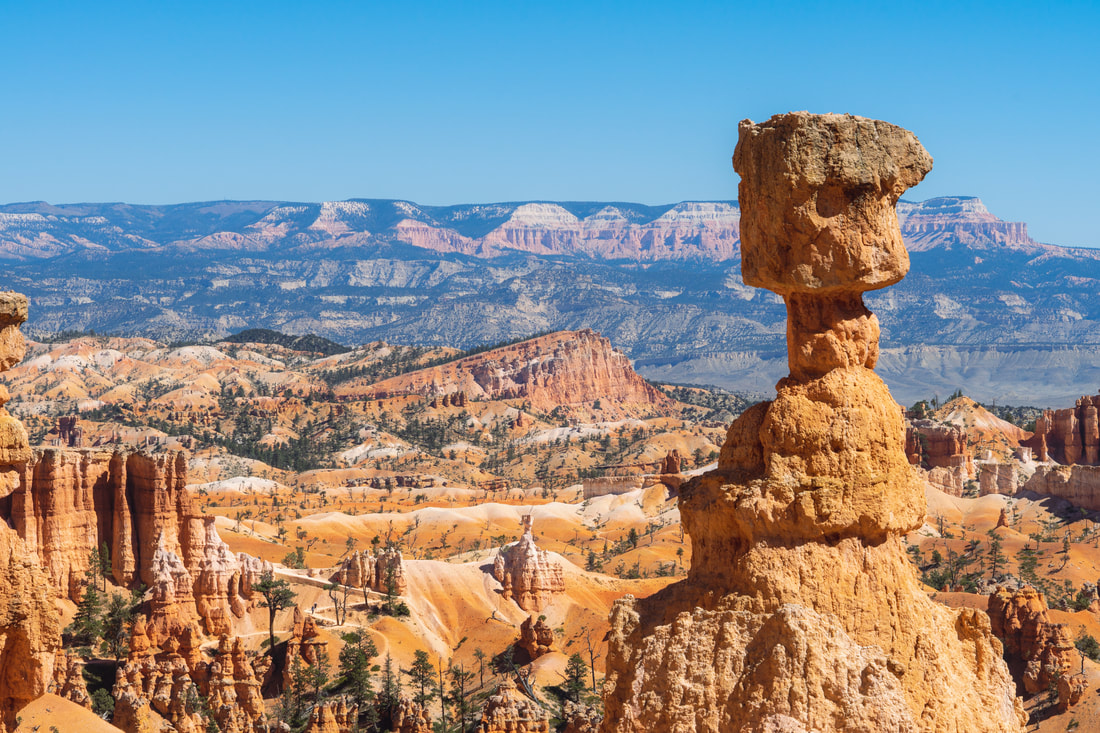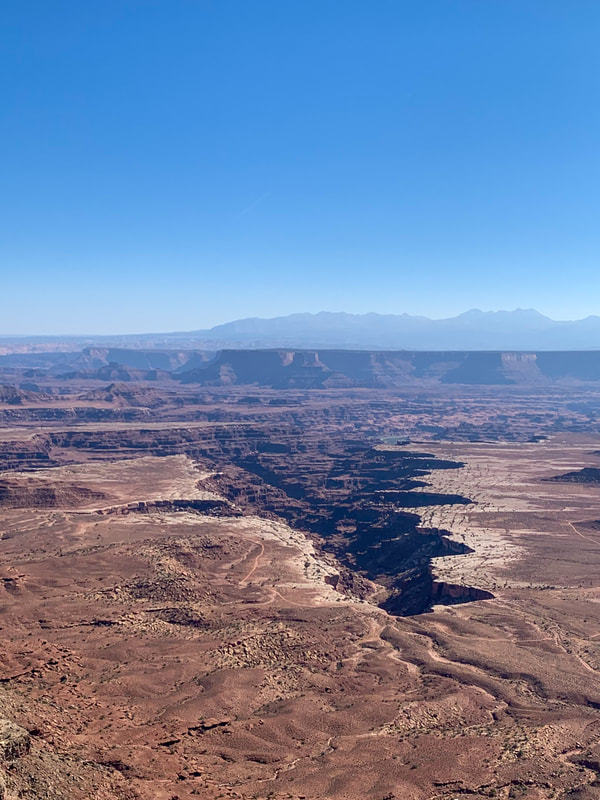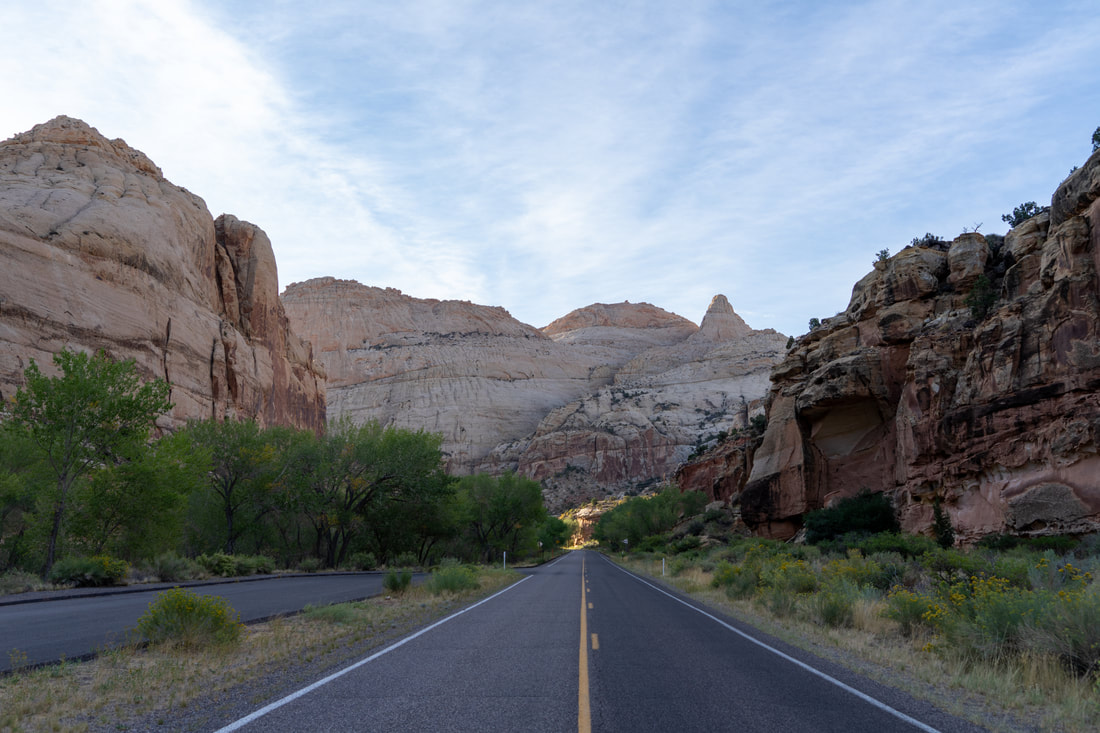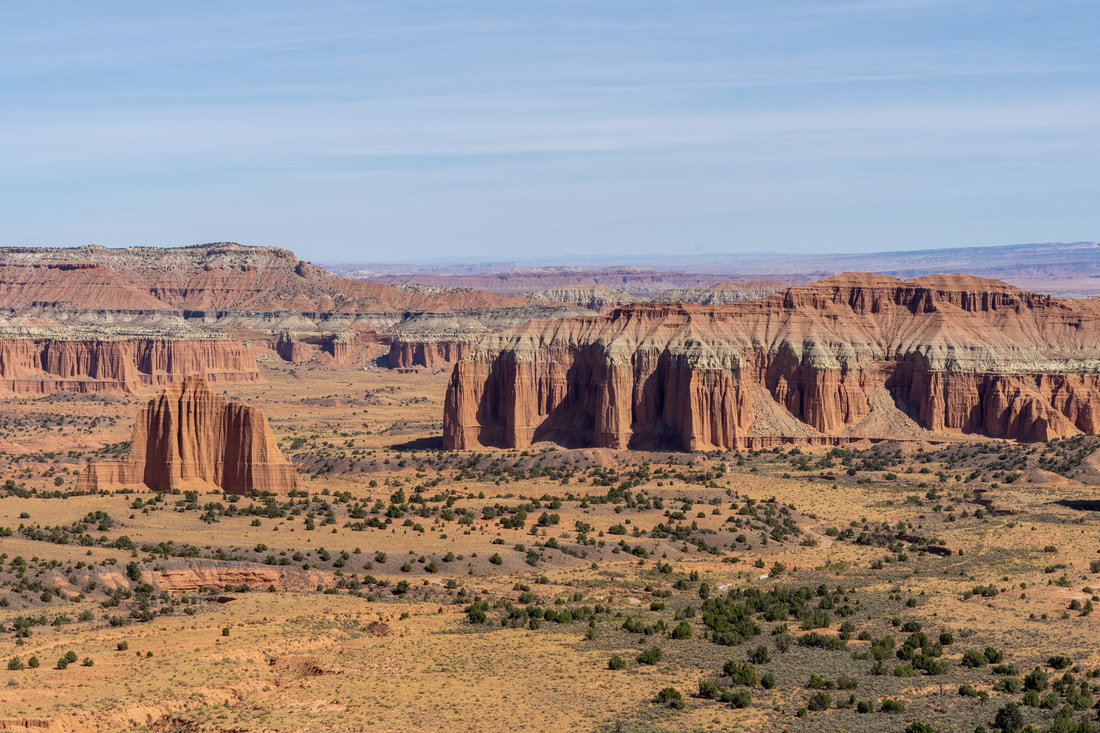|
A look at "Thor's Hammer" and beyond in Bryce Canyon National Park My drive from Capitol Reef to Bryce Canyon was one of the most peaceful and enjoyable drives during my road trip odyssey. Perhaps the knowledge that I would end my day in Las Vegas heightened my ability to enjoy the moment. I drove on a quiet highway, passing small towns and valley farms, listening to Aristotle's Poetics on audiobook. At some point, the orange dividing lines on the road disappeared, and the road turned into what we called home a "black-top" or a no-frills strip of asphalt. I consulted Google Maps to make sure I hadn't made a wrong turn. It assured me that I was indeed on the right path to my destination. I settled into the drive and reflected on the preceding weeks, the people I met, the places I visited, and the chance to connect with something beyond, that ineffable something that lifted me from the doldrums. I felt the most profound sense of gratitude. I arrived at the Bryce Canyon Visitor Center and got the last stamp of the trip in my National Parks passport book, then set out to see what there was to be seen. I didn't know what to expect from Bryce Canyon, except when I mentioned it to people who had been there, they all had the same look on their face. It was a look of delight. Their eyes smiled, and their head nodded in knowing affirmation, followed by a, "Oh, you're going to love it." Strolling among the hoodoos Bryce Canyon was one of the biggest surprises of the trip and perhaps the most magical of all the landscapes. It's not a canyon. It is numerous canyons and amphitheaters carved into the side for a forest-covered plateau. The canyons boast the largest concentration of irregular rock columns, called hoodoos, in the world. The towering spires and sandstone walls stand proud and defiant against the elements prone to batter. The rugged beauty of this area is a testament to the audacity of the natural world. As I bopped down the trail from Sunrise Point, I came across another surprise. I noticed a hiker in front of me and further down the trail — a woman with a slight hitch in her step. As the gap between us closed, a thought popped into my head. "It can't be," I told myself. I blinked my eyes rapidly, rubbed my eyes cartoonishly, and looked again. The backpack was the same color, and she appeared to be nursing a sore ankle. "Is that…?" I passed her on the left, trying very much not to be creepy while looking back at her. She stopped in her tracks. "Nathan?!" “Lena?" I retorted, feigning perplexity with my voice. Sure enough, it was her, the hiking companion I met in Arches National Park two days prior. We picked up right where we left off. "How's your ankle?" "What did you think of Capitol Reef?" "No, I won't judge you for wearing the same clothes you were wearing two days ago." The delight of this chance encounter made the land seem more magical. The conversation turned to banter, and we joked about what other hikers were thinking. We took our time strolling the trail, gawking at the scenery, and snapping pictures along the way. We climbed up the Navajo loop trail through the narrow canyon called Wall Street and arrived at the canyon rim at Sunset Point. A decision had to be made. I opted to head back down into the canyon to see a bit more — it was my last day in the wild, and I wanted to make the most of it. She decided it was best not to push her luck with her tender ankle. So we wished each other well and went our separate ways. If life were a Hallmark movie, perhaps the story would not have ended there. But experience has taught me that life is not a movie, and I've learned to say my goodbyes. Except for the exchange of a few text messages, we have not spoken since. I rolled into Las Vegas as the sun was setting. I was greeted enthusiastically by my dear friends, who welcomed me into their home. "How was your trip? Tell us all about it!” I stumbled. Where do I even begin? I thought to myself. How can I possibly explain the journey of these past 40 days? It wasn't just the places seen over the many miles driven. It was over the rugged landscape of my soul that the greatest distance was traveled. After I returned to Los Angeles I wrote this reflection. Journey's End 40 days. 7 states. 9 National Parks. 4,408 miles driven. 110 miles hiked. 1,448 photographs snapped. 60 hours of audiobooks. I drove through 115-degree heat and a snowstorm. I traversed mountains peaks, weaved through canyons, stumbled through deserts, felt wind rumble forests, and watched time float down rolling rivers. I saw numerous bison, elk, deer, and antelope. I met two Red foxes and one lonely rattlesnake. I traveled solo, but I did not travel alone, for I met many fellow sojourners along the way. What was I looking for? I still don’t know. There was no epiphany, only the rediscovery of the many tiny miracles; in each sunrise and sunset; around dusty corner bends; in the smile of a welcoming host; in the chilly air of the starry night sky; in the enduring rhythms of life in a world away from humankind. I encountered the great Silence, and it was divine. A sublime sunset over Yellowstone
0 Comments
Mesa Arch frames the rugged sandstone landscape in Canyonlands National Park I left Arches early on Sunday morning to head to nearby Canyonlands National Park. I entered the park from the north in the "Island in the Sky" district, which is how, I believe, most people view Canyonlands—from above, looking over the landscape's cavernous rifts. To say the area is vast would be too obvious. Words and pictures fail to capture its scope, which invoked a sense of both wonder and frustration. My eyes could not open wide enough to consume the whole of it. Still, there was a desire to draw closer, to descend its water-worn walls, to feel the timelessness more intimately. To access the canyon floor would require a 2–6 hour drive—depending on where you're heading—through the east entrance of the park. I did not have the time for that, so I had to settle for a couple of short 1–2 miles hikes above the rim and a promise to the land: "I'm not done with you," I whispered as I drove away in the early afternoon. The official line is that water and time carved this epic ditch in the earth. I think it looks like God took an ax and split the earth open. I arrived in Capitol Reef National Park in the evening hours when the sun paints the red rock walls with its orange-hued light before retiring for the day. It was a lovely welcome. Capitol Reef stretches nearly 100 miles from north to south along the geologic formation called the Waterpocket Fold. It's basically a lift—or monocline—in the rock layers of the earth's crust that occurred during a "big event" 50-70 million years ago. An ancient fault lifted rock layers on the west side more than 7,000 feet above the rock layers on the east side. Over the millions of years that followed, ongoing erosion carved and crafted its novel and colorful formations and canyons. "Follow the light" On the road into Capitol Reef National Park While the park runs north-south, the only highway that enters the park runs east-west. The park's scenic northern and southern districts can only be reached via dirt roads that require high-clearance, four-wheel-drive vehicles. I had one full day at the park. The allure of being in a place that so few people visit enchanted me, so I arranged for a guide to take me, via a suped-up Jeep, to the Cathedral District in the north end of the park. My guide was a friendly young man, perhaps in his late 20s. A Utah native, his heart and love for his home state was evident. He worked for the park service as a guide most of the year. During the offseason, he lived simply, often on nearby BLM (Bureau of Land Management) land camping out of his truck. We turned off the highway onto a sandy path that led to the wind- and rain-chiseled sandstone cliffs that reminded early settlers of the flying buttresses of gothic cathedrals. My guide snapped this picture of me as we explored the "Temples of the Sun and Moon" What struck me, beyond the alien formations of the land, was the silence. City-living is a cacophony of noise. You can't escape it. But here, with the car engine off, without wind, animals, or movement, and void of the rhythms of life's sundry sounds, there was a marvelous stillness. My deafened ears grasped for a note to reassure me that my sense of hearing was still functional. In this kind of deep silence, you become aware of an otherness—that thinly veiled something that is always there, but we are unable to grasp in the commotion of life's comings and goings. It is the sense of infinitude, the everlasting and boundlessness of life that sits just beneath the surface of our everyday experiences. "Am I still on planet earth?" My guide explained the differences in rock layers—basalt, sandstone, shale—and I nodded my head like I understood what he was talking about. We traversed the wild landscape for six hours, and since it was just the two of us, the conversation spanned the whole spectrum of topics. We reviewed our favorite movies and shared religious philosophies while touching dinosaur bones and ancient lava flows. When I retired to my room for the night, I felt a bit of melancholy. It was the eve of the final day of my 40-day adventure. The next night, I would return to the bright lights and swirling sounds of civilization. But before I got there, I had one last stop to make— Bryce Canyon. A look down at the "flying buttresses" of the Cathedral Valley, a place where the silence is numinous.
|
AuthorA WRITER AND TRAVELER KEEPING THE FAITH IN LOS ANGELES Subjects
All
Archives
August 2022
© 2022
|











 RSS Feed
RSS Feed